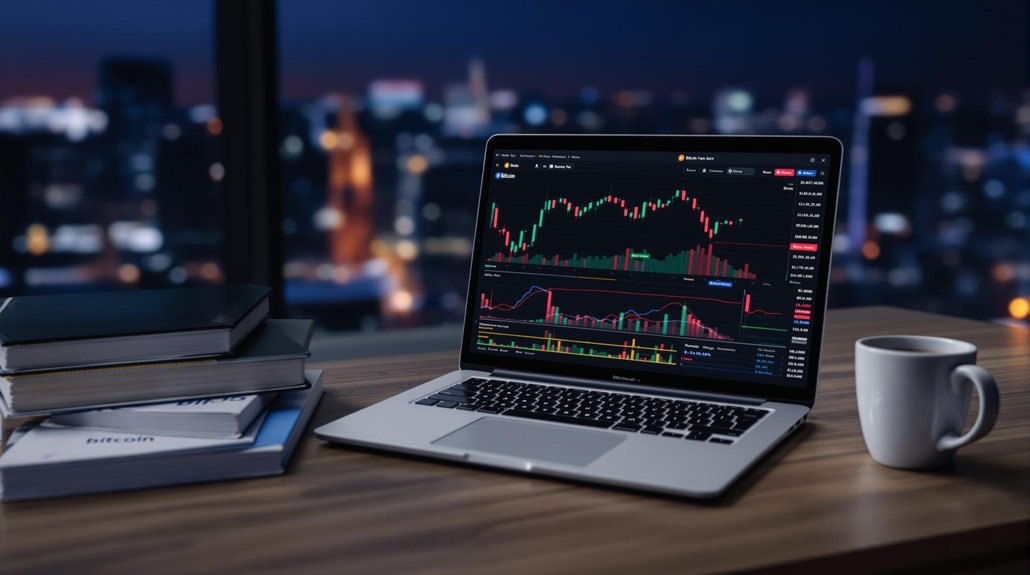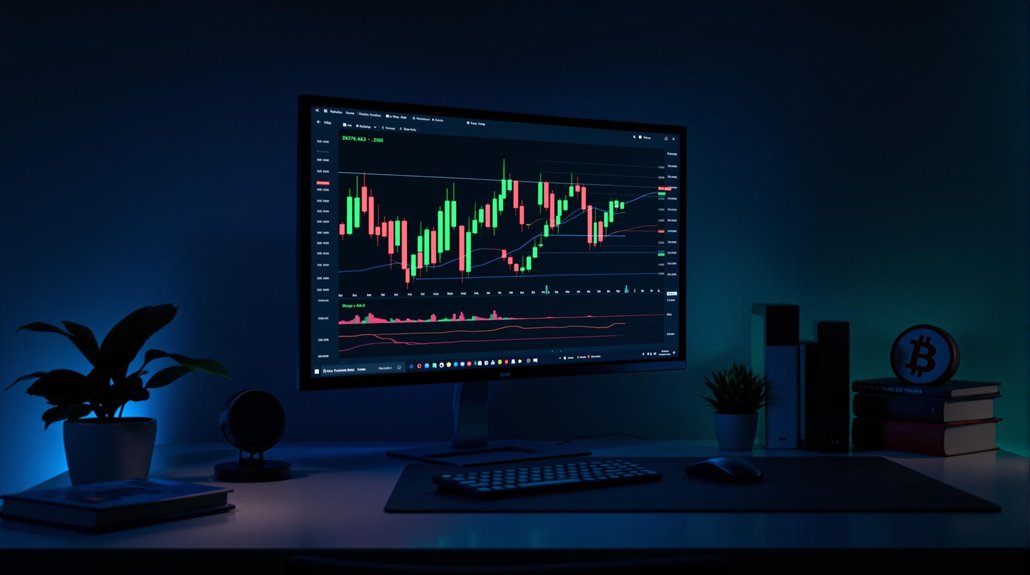Trading Bitcoin starts by choosing a cryptocurrency exchange and creating a secure account with two-factor authentication. Traders need to understand basic concepts like market orders, limit orders, and trading pairs. They can focus on short-term day trading or long-term holding strategies. Most beginners start with spot trading, buying and selling actual Bitcoin, while using price charts and technical indicators. Successful traders develop strategies and manage risks through careful position sizing and stop-loss orders.
Quick Overview
- Choose a reputable cryptocurrency exchange like Binance, verify your identity, and enable two-factor authentication for secure trading.
- Start with small investments and practice using market orders, limit orders, and stop-loss orders to manage trades effectively.
- Learn basic technical analysis to read price charts and use fundamental analysis to understand market trends.
- Implement risk management by setting stop-loss orders and never investing more than you can afford to lose.
- Keep detailed records of all trades for tax purposes and stay updated on Bitcoin news affecting market prices.

Trading Bitcoin begins with choosing a cryptocurrency exchange and understanding basic trading concepts. When selecting an exchange, traders compare different platforms based on their fees, security features, and the variety of cryptocurrencies they support. After choosing an exchange, users create an account, complete identity verification, and fund it with regular money or transfer existing cryptocurrency. It’s common practice to enable two-factor authentication for added security. The most popular exchange, Binance supports 350+ cryptocurrencies for trading. Many beginners prefer to start with hot wallets for easier access to their funds. Popular platforms like Coinbase offer staking to earn passive income while holding cryptocurrencies.
Traders need to understand several key terms before getting started. Market orders execute trades immediately at the current price, while limit orders only execute when Bitcoin reaches a specific price. Stop-loss orders help protect against significant losses by automatically selling when prices drop to a certain level. Trading pairs, like BTC/USD or BTC/EUR, show which currencies are being exchanged. Bitcoin prices can be quite volatile, changing rapidly throughout the day. Swing trading strategies are popular among beginners who prefer medium-term positions.
A trading strategy helps guide decision-making in the Bitcoin market. Some traders focus on short-term gains through day trading, while others prefer long-term investing through a buy-and-hold approach called “HODLing.” Many traders use technical analysis, studying price charts and indicators to predict future movements. Others rely on fundamental analysis, looking at news and market trends that might affect Bitcoin’s value. Before trading with real money, some traders test their strategies using historical data.
Risk management plays a vital role in Bitcoin trading. Many traders start with small positions to gain experience without risking too much money. They use stop-loss orders to limit potential losses and take-profit orders to lock in gains when prices rise. Record-keeping is important for tax purposes, as cryptocurrency trades need to be reported. Successful traders stay informed about Bitcoin news and market developments that could affect prices.
Trading platforms offer different tools to help traders analyze the market. Price charts show Bitcoin’s historical performance, while technical indicators help identify potential trading opportunities. Spot trading involves buying and selling actual Bitcoin, while derivative trading uses financial instruments based on Bitcoin’s price.
Traders regularly review their performance and adjust their strategies based on market conditions. The cryptocurrency market operates 24/7, allowing traders to buy and sell Bitcoin at any time, but this also means prices can change dramatically even while they sleep.
Frequently Asked Questions
What Happens to My Bitcoin if the Trading Platform Gets Hacked?
If a trading platform gets hacked, users’ bitcoins could be stolen, and their accounts might be frozen temporarily.
While many exchanges keep most funds in secure cold storage and have insurance, there’s still a risk of loss.
Some platforms reimburse users after hacks, but it’s not guaranteed.
The hack can also affect bitcoin prices and cause delays in withdrawals.
Some exchanges work with law enforcement to track and recover stolen funds.
Can I Trade Bitcoin Without Verifying My Identity?
Yes, it’s possible to trade Bitcoin without identity verification using certain platforms. These are often called “no-KYC” exchanges.
Popular options include Bisq and HodlHodl, which are peer-to-peer platforms. However, these platforms typically have lower trading limits and might charge higher fees.
Some countries have strict rules about anonymous trading, and many mainstream exchanges require ID verification to comply with regulations.
No-KYC platforms usually support fewer payment methods than traditional exchanges.
Why Do Bitcoin Prices Vary Across Different Trading Platforms?
Bitcoin prices differ across trading platforms due to several key factors.
Each exchange operates independently, with its own supply and demand. Local market conditions and varying trading volumes affect prices differently.
Some exchanges have more buyers than sellers, while others have the opposite. Time delays in price updates and different fee structures also contribute to price gaps.
Geographic locations can create unique price differences, like South Korea’s “Kimchi Premium.”
Are Bitcoin Trading Gains Taxable in My Country?
Bitcoin trading gains are typically taxable in most countries.
Tax authorities often treat crypto profits like other investment income. The rules vary widely between nations – some have high tax rates, while others don’t tax crypto at all.
Countries like Portugal and Singapore have zero crypto taxes, while the US and Australia charge capital gains tax.
Each country has its own reporting requirements and tax rates for crypto transactions.
What Is the Minimum Amount of Money Needed to Start Trading Bitcoin?
Most people can start trading Bitcoin with as little as $5-$10 on popular exchanges. There’s no need to buy a whole Bitcoin – traders can purchase tiny fractions instead.
While Bitcoin ATMs typically require $20-$50 minimums, online platforms like Cash App and PayPal allow smaller amounts. Exchange policies and payment methods affect these minimums.
Professional crypto funds, like those on Yieldstreet, have higher requirements around $25,000.





